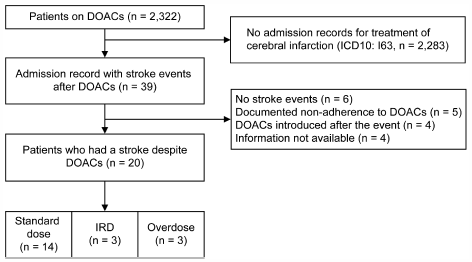- 著者
- Aya Ueda Shinji Toki Chisato Kitayama Manabu Akazawa
- 出版者
- The Pharmaceutical Society of Japan
- 雑誌
- Biological and Pharmaceutical Bulletin (ISSN:09186158)
- 巻号頁・発行日
- vol.43, no.7, pp.1135-1140, 2020-07-01 (Released:2020-07-01)
- 参考文献数
- 19
- 被引用文献数
- 4
Inappropriately reduced doses (IRDs) of direct oral anticoagulants (DOACs) are common in clinical practice. We performed a retrospective review using electronic medical records of St. Marianna University School of Medicine Hospital (a 1200-bed teaching hospital in Japan) to address the prevalence of IRDs and patient-related factors that result in IRDs. We also surveyed DOAC-treated patients who were hospitalized due to a stroke during the 5-year study period to analyze the association between stroke events and IRDs. We found that one in five patients who were newly prescribed a DOAC was treated with IRDs. Patients treated with edoxaban received the most IRDs (64%, 7/11), followed by those treated with dabigatran (50%, 1/2), apixaban (32%, 19/61), and rivaroxaban (27%, 12/44). Our analysis showed that the renal function (measured as serum creatinine and creatinine clearance values) and age are possible factors influencing dose reduction. The HAS-BLED score and antiplatelet use were not associated with IRD prescription. An analysis of the 5-year hospital records revealed 20 stroke cases despite ongoing treatments with DOACs, and IRDs were noted in three of these cases. In all three cases, the patients had been on an IRD of rivaroxaban. To prevent IRDs of DOACs, we suggest that a clinical protocol be incorporated into formularies to support the prescription process.
